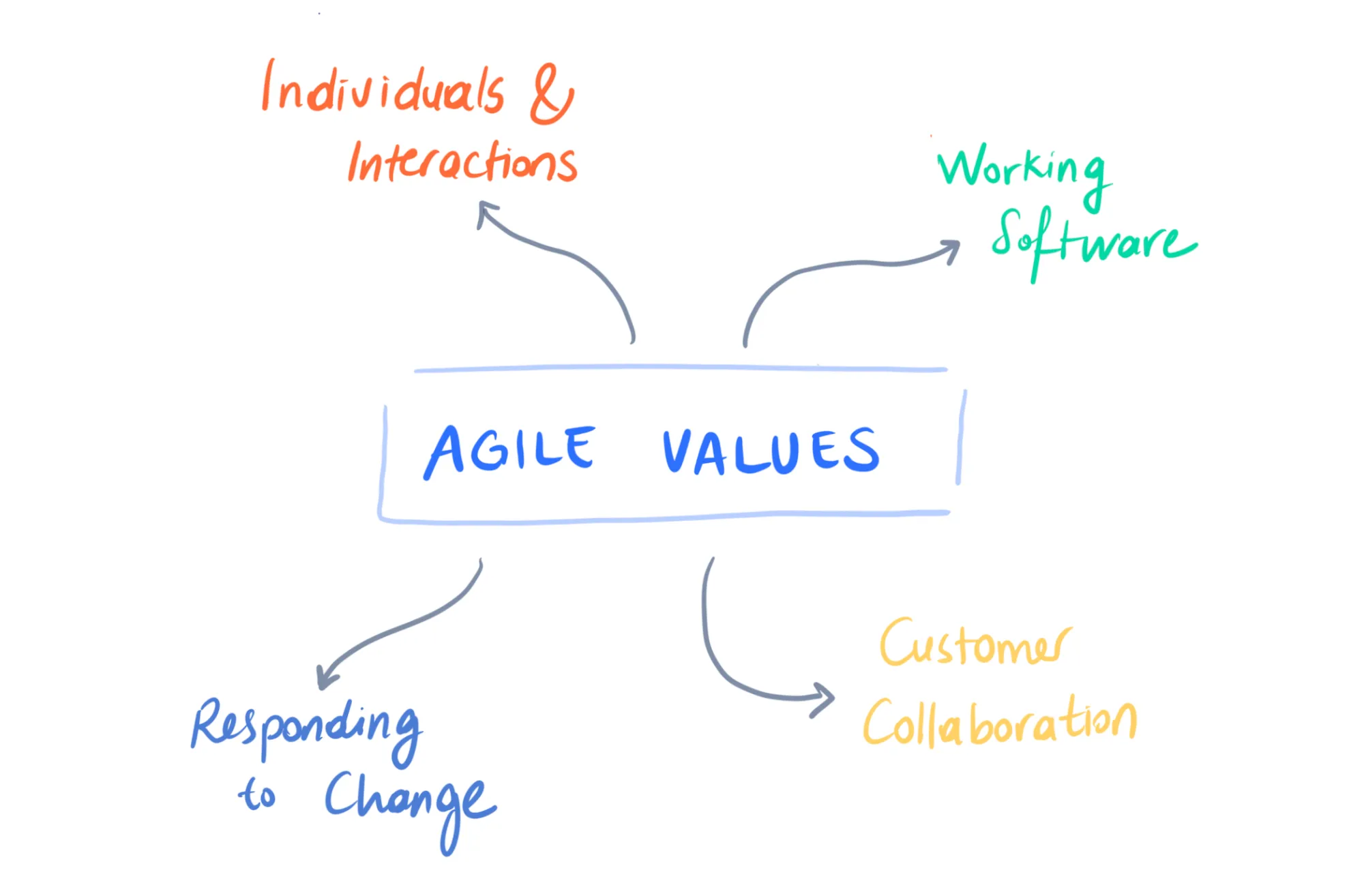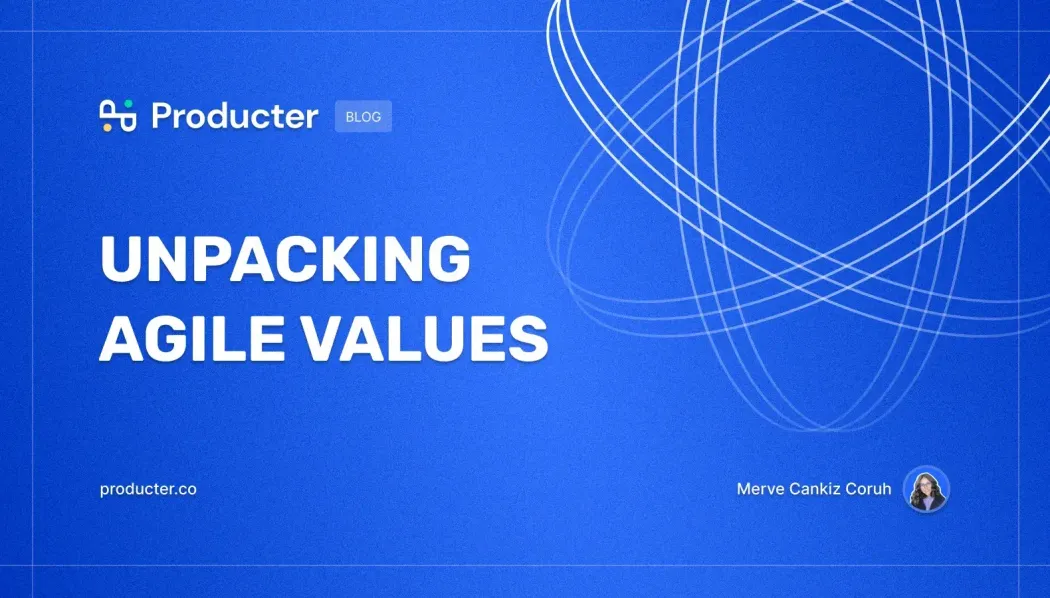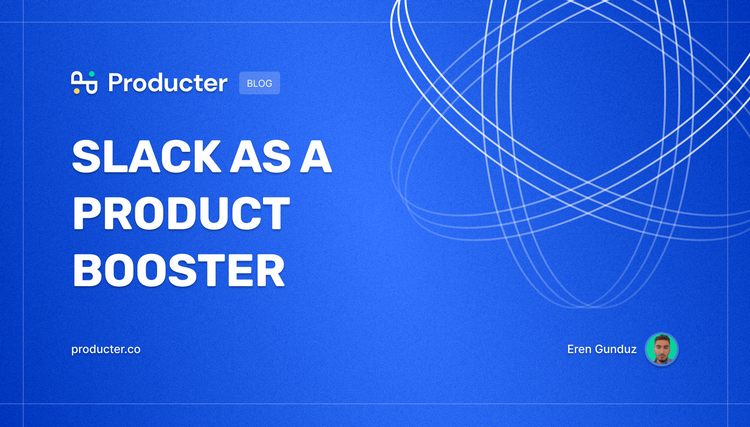TL;DR
The Agile methodology centers on four critical values: individuals and interactions, working software, customer collaboration, and response to change.
This in-depth guide explores agile values, their significance, and real-life examples in the context of software development success.

Agile Values: The Foundation of the Agile Manifesto
The Agile methodology, which has revolutionized the field of software development, promotes a set of four intrinsic values:
- Emphasizing individuals and interactions over processes and tools.
- Valuing working software over exhaustive documentation.
- Highlighting customer collaboration over contract negotiation.
- Preferring response to change over following a static plan.
These Agile values serve as guiding principles for efficient and effective software development, as they concentrate on areas that genuinely contribute to product success.
To understand the depth of these principles, let's delve into each Agile value:

Agile Value 1: Individuals and Interactions
The first value of Agile methodology prioritizes "Individuals and Interactions" over processes and tools.
It's a departure from the traditional belief in the software development world that having the perfect set of tools and processes equates to the successful completion of a project.
Instead, Agile methodology asserts that it's the people involved - their skills, communication, and collaboration - that truly drive a project to its successful completion.
In any software development project, the participants bring a wide range of skills and expertise. Developers, product managers, testers, UX designers, and other stakeholders all bring their unique perspectives and abilities.
While processes and tools are necessary, they alone can't guarantee success. It's how the individuals involved interact with each other, using those tools and processes, that dictates the outcome.
Real-World Example for Agile Value 1
Let's take a real-world example to further illustrate this point:
Imagine a software development team working on a new mobile app for a client. They have access to state-of-the-art software development tools and have adopted a seemingly flawless process for development.
However, the team operates in silos, with poor communication and minimal interaction. The developers aren't clear about the customer's vision, the testers don't fully understand the developers' approach, and the product managers are struggling to keep everyone on the same page.
In contrast, consider a team with modest tools and a simple process. However, this team has a culture of open communication, regular collaboration, and mutual respect.
Every morning, they huddle to discuss the day's tasks, challenges, and possible solutions. They have regular interactions with the client to ensure they're working in the right direction.
Between the two scenarios, the second team is more likely to deliver a successful project, despite having less sophisticated tools and processes. That's because they understand and embody the Agile value of prioritizing individuals and interactions.
This value encourages creating a work environment that fosters communication, collaboration and shared understanding. Regular stand-ups, pair programming, code reviews, and a culture of feedback are some ways Agile teams implement this value.
In essence, the Agile approach recognizes and values the human element in software development, understanding that it's individuals who bring processes and tools to life.

Agile Value 2: Working Software
The second Agile value places greater emphasis on "Working Software" over comprehensive documentation.
Traditional software development models often involved creating exhaustive documentation detailing each feature, functionality, and architecture of the system even before a single line of code was written. While this meticulous planning helped define the project's path, it often led to significant delays in delivering actual usable software to the customer.
Agile's approach challenges this norm. It values a functional piece of software more than a stack of documents. This principle propels teams to produce a working version of the software quickly, allowing for customer feedback and iterations sooner in the process. It facilitates a more dynamic, customer-centric approach to software development.
Real-World Example for Agile Value 2
To put this into perspective, let's consider an example:
A software development company is creating an e-commerce platform for a client. With the traditional approach, the team would first create comprehensive documentation detailing all the features of the platform - like the product catalog, user accounts, shopping cart, payment processing, order tracking, and more.
This process of creating documentation could take several months before any actual development begins. By the time a working version of the software is ready for the client to review, market conditions may have changed, or the client might have received feedback from users that necessitate changes in some features.
Contrast this with an Agile approach: The development team focuses on building a minimum viable product (MVP) first. The MVP could include just the product catalog and shopping cart features.

They present this working software to the client much earlier in the process, allowing the client to test the platform, gather initial user feedback, and identify improvements or changes. The team then iterates on the software, incrementally building and improving upon it based on the feedback received. This process ensures that the software remains relevant and adaptable to the user's needs.
This Agile value does not imply that documentation is unnecessary. Documentation is still vital for maintaining the project's clarity and future reference. However, the Agile approach advocates that documentation should not impede or delay the delivery of working software.
The "working software over comprehensive documentation" principle underscores the importance of delivering value to the customer early and frequently, maintaining a customer-focused perspective, and embracing adaptability in the face of changing requirements.

Agile Value 3: Customer Collaboration
Agile's third value prioritizes "Customer Collaboration" over contract negotiation. In traditional product management models, particularly the waterfall model, the project's scope and deliverables are defined in a contract upfront.
After that, the project follows a linear path with little to no room for modification, regardless of whether the end product meets the user's evolving needs.
Agile methodology flips this notion by advocating for continuous customer collaboration throughout the project. It establishes a feedback loop where customers can regularly review and give feedback on the delivered increments of the project, ensuring that the final product is closely aligned with their expectations.
Real-World Example for Agile Value 3
To visualize this, let's consider a real-world example:
Suppose a software company has been hired to build a bespoke Customer Relationship Management (CRM) system for a growing business. In a traditional model, the company and client would agree on a detailed contract specifying all the features, interfaces, and reports the CRM should have.
The development team then works on building these features, and only after the entire system is ready does the client get to use it. By this time, the client's business may have evolved, and they may need different features or modifications to the original specifications.

However, the contract might not allow for such changes without significant renegotiation and potentially additional costs.
On the other hand, in an Agile model, the development team would collaborate closely with the client throughout the project. They might start by building a basic version of the CRM with key features like contact management and lead tracking.
The client could start using this initial version and provide feedback about what's working, what's not, and what additional features they need. The development team would then incorporate this feedback into the next iteration of the software, continually refining and expanding the CRM system to align with the client's growing business.
This continuous collaboration not only ensures that the software remains relevant and useful but also builds a strong relationship between the development team and the client, resulting in better communication, mutual respect, and, ultimately, a more successful product.
This Agile value is not about discarding contracts but ensuring that they don't hinder active collaboration and adaptation to changing customer needs. The ultimate goal is to create software that delivers real value to the customer, and continuous customer collaboration is central to that goal.

Agile Value 4: Responding to Change
Agile's fourth value emphasizes the importance of "Responding to Change" over following a fixed plan.
Traditional product management models, such as the Waterfall model, typically involve creating a detailed, fixed plan at the beginning of a project. While this can provide a clear roadmap, it offers little flexibility to adapt when requirements change, technology evolves, or market conditions shift.
In contrast, Agile methodology values flexibility and responsiveness. It encourages teams to anticipate change and adapt their strategies and plans accordingly, ensuring that the product stays relevant and continues to deliver value.
Real-World Example for Agile Value 4
To illustrate this principle, let's consider a real-life example:
Imagine a software development company working on a new financial planning app. According to their original plan, they've designed the app to pull data from users' bank accounts to track spending and provide budgeting advice. However, midway through development, a new government regulation is introduced that imposes stricter rules on how apps can access and use banking data.
In a traditional product management model, this change could cause significant disruptions, as the team would have to reassess their entire plan and renegotiate contracts, leading to delays and possibly increased costs.
In an Agile approach, however, the team would be prepared to respond to this change. They would have been regularly reviewing their progress, market conditions, and potential risks and would have kept their plan flexible.
Upon learning about the new regulation, they might quickly pivot their strategy to comply with the rules, perhaps by integrating with an approved data aggregation service. They would then adjust their development tasks and timeline accordingly and inform the stakeholders about the change and its implications.
This value doesn't mean that planning is unnecessary in Agile. Quite the opposite, planning is an ongoing activity that helps teams adapt to new information and changing conditions. The Agile approach to planning is iterative and flexible, keeping the project on track without losing sight of its ultimate goal: delivering value to the user.
In essence, Agile teams understand that change is not a disruption but an opportunity. By responding to change, they can ensure their software meets the real, current needs of its users, making it more useful and competitive.
Frequently Asked Questions on Agile Values
Q: How can Agile values be implemented in a SaaS startup context?
A: Implementing Agile values in a SaaS startup involves fostering a culture of open communication, encouraging frequent customer interaction, focusing on delivering working software frequently, and maintaining the flexibility to pivot as market demands change. Key strategies can include scrum meetings, regular sprint reviews, customer feedback loops, and maintaining a dynamic product roadmap.
Q: What Agile practices can help speed up the product development cycle in a SaaS startup?
A: Agile practices such as Continuous Integration/Continuous Delivery (CI/CD), Test-Driven Development (TDD), and frequent iterations can significantly speed up the product development cycle. Using an MVP (Minimum Viable Product) approach can also help to get the product in front of customers faster, enabling the collection of user feedback for further improvements.
Q: How can Agile values help my SaaS product stay competitive in a rapidly evolving market?
A: Agile values prioritize customer satisfaction, working software, team collaboration, and responsiveness to change - all of which can help your SaaS product stay competitive. By continuously adapting to customer feedback and market changes and regularly delivering improvements, your product can stay relevant and valuable to users, helping you maintain a strong market position.
Q: How can Agile values improve collaboration and communication within a distributed team in a SaaS startup?
A: Agile values can enhance collaboration and communication within distributed teams by promoting regular interactions (like daily stand-ups and sprint retrospectives), fostering a culture of shared responsibility, and using collaborative tools effectively. It emphasizes the importance of individuals and their interactions over processes and tools.
Q: How can we manage scope creep in our SaaS product development while adhering to Agile values?
A: Agile values and principles provide a framework to manage scope creep effectively. Through iterative development, regular customer collaboration, and welcoming changes, Agile methodology allows teams to constantly re-evaluate priorities and adjust the scope based on customer feedback and business value, preventing unnecessary feature bloat.
Q: How can Agile values help in managing technical debt in our SaaS startup?
A: Agile values encourage frequent reflection on how to become more effective and tuning and adjust behavior accordingly. This principle can be applied to manage technical debt by incorporating tasks to address technical debt in the product backlog and tackling them iteratively, along with new feature development.
Q: Why are Agile values critical in software development?
A: Agile values guide software development towards efficient and effective practices by prioritizing human interactions, customer satisfaction, iterative progress, and adaptability. These principles
help teams deliver software that is not just functional but also closely aligned with user needs.
Q: Can Agile values be applied beyond software development?
A: Absolutely. While Agile values originated in the context of software development, their emphasis on collaboration, customer satisfaction, and adaptability can benefit any product that requires flexibility, feedback, and a team-oriented approach.
Q: How do Agile values affect the day-to-day operations of a development team?
A: Agile values shape a team's operations by promoting regular communication, iterative progress, frequent feedback, and adaptability. Teams might hold daily stand-ups to foster interaction, use pair programming to develop working software, regularly engage with the customer for feedback, and revisit their product roadmap as necessary to accommodate change.
Conclusion
- The Agile Manifesto and its four cornerstone values - "Individuals and Interactions," "Working Software," "Customer Collaboration," and "Responding to Change" - have revolutionized the software development landscape, allowing teams to be more responsive, efficient, and customer-centric.
- As we've explored in this article, these values are not just theoretical concepts but practical guidelines that can significantly impact the way we approach software development.
- By understanding and embracing these Agile values, organizations can build robust software teams that communicate effectively, create working software that genuinely solves user problems, foster meaningful collaboration with customers, and dynamically adapt to changing circumstances.
- We've unpacked each value, providing concrete examples that bring to life these principles in action.
- Moreover, these Agile values have significant implications beyond software development. Whether you're a SaaS startup looking to accelerate your product development cycle, a distributed team aiming to enhance collaboration, or a business striving to stay competitive in a rapidly evolving market - the Agile values offer a roadmap to success.
- As we navigate the challenges of the 21st-century software development landscape, the Agile Manifesto serves as a timeless guide, reminding us that at the heart of every successful project are individuals and their interactions, working software, customer collaboration, and the flexibility to respond to change.
- Embracing these Agile values will not only make us better software developers but will also ensure that we continue to deliver exceptional value to our customers.
Resources for Product Managers:
📚 Download Miro's template below if you need an icebreaker for you to introduce agile values to your team.
Watch the video below to get a quick intro to the agile methodology and agile values 👀
If you found this in-depth guide on Agile values insightful, please share it with your network.
We value your thoughts and questions, so feel free to leave a comment below!
Last Updated: June 15, 2023 - for accuracy and comprehensiveness.





